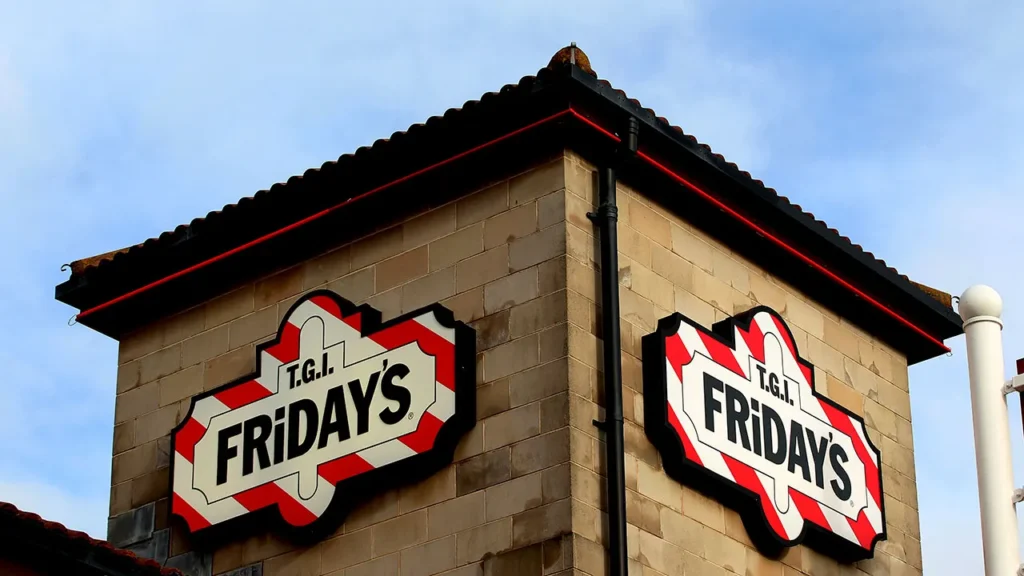TGI Fridays, which was once an American icon, is now a shadow of its former self. From being the original singles bar in the US, a happy hour favorite where bartenders performed tricks, it became more popular in the 70s and 80s. The chain has faltered in recent years, however, closing more than 200 restaurants since 2019, and in November, it declared bankruptcy. Why? A flawed capital structure and the aftereffects of the pandemic.
The Early Days: A Side Business Turned Legendary
Alan Stillman, a restaurateur in New York, founded the first TGI Fridays in 1965 with the goal of meeting the flight attendants in his area. He confesses it was all about picking up women. Is it safe to say you entered the business because you wanted to pick up women? Stillman’s response: “Absolutely fair, not only fair, but accurate and true, and it worked.” What began as a side hustle, funded by a $5,000 loan from his mom, exploded quickly.
The restaurant’s initial success stemmed from recognizing its niche—a destination where young adults could socialize with other young adults, sometimes while standing at the bar. Bartenders were trained extensively, learning almost 500 cocktails and doing tricks to amuse customers. It was all about entertainment. The restaurant also featured an annual bartender championship that demonstrated superior technique and flair.
TGI Fridays Expands: A Change in Strategy

They first franchised in the US in 1967, and then internationally in 1986. Through a dominant presence in most countries, TGI Fridays became the byword for that classic American experience. But over the years, the company began to change direction. During the 90s and 2000s, the emphasis shifted from the bar and grill model towards appealing more to families. Others contend this was a blunder, as it watered down the brand messaging. TGI Fridays was not merely a bar anymore; it attempted to cater to all, which made it more difficult to differentiate.
Why did TGIF fail?
By 2008, the US sales of TGI Fridays reached their peak, but subsequently declined after the recession. Two private equity companies acquired TGI Fridays in 2014, and Triartisan subsequently acquired Sentinel in 2019. The company attempted to revive itself by offering deals such as unlimited apps, but they did not work in the end. The company went so far as to offer endless apps in an attempt to bring in customers, which failed to turn the sales decline around.
In 2017, TGI Fridays entered into a whole business securitization deal, a financial transaction in which investors lend to a company in return for bonds backed by franchisee royalties. The deal suited well for chains such as Domino’s and Jimmy John’s, but for TGI Fridays, there were covenants and dangers. The biggest danger? The pandemic.
In 2020, the pandemic prompted TGI Fridays to shutter 50 US restaurants, and the overall sales dropped below the level required by the financial deal. Consequently, the franchisee-paid royalties were used for repaying investors, as opposed to investing in the business itself. Although TGI Fridays did quickly reopen, the bounce-back wasn’t enough. Other chains followed suit, draining business further.
Unsuccessful Moves and Diminishing Popularity
To be competitive in the evolving environment, TGI Fridays began offering sushi. The restaurant chain teamed up with a ghost kitchen platform named C3, which featured a sushi brand named Krispy Rice. TGI Fridays started selling sushi in its restaurants, but the decision was criticized because it was entirely off-brand from the American bar atmosphere. It created complexity without bringing in enough revenue to support it.
By 2023, TGI Fridays was a brand in freefall. Customers were griping about the long wait times for food, with some lamenting that it “tastes old.” The chain had also experienced a monumental succession of CEOs, which affected the stability of the company. Consequently, TGI Fridays was now experiencing some serious financial difficulties, including the securitized debt of 2017.
Bankruptcy and the Future
In April of 2023, TGI Fridays signed an agreement to be acquired by its biggest franchisee, Hostmore, and become public on the London Stock Exchange. This Hail Mary pass failed, however, and the fate of the company was sealed when it declared bankruptcy. It wasn’t alone among restaurant chains in 2023 to be dealt this hand. Restaurant chains across the country were pummeled by changing consumer habits, leading to a spate of bankruptcies.
Although the franchised operations of the company avoided bankruptcy, the future is not bright. Franchisees have more questions than answers and do not know what this portends for them, given leadership turmoil and financial issues.
Key Takeaways
The collapse of TGI Fridays is a cautionary warning about how the greatest brands can get lost. There are some key takeaways from this case:
- Identity Crisis: Departure from the initial bar model to accommodate families watered down TGI Fridays’ identity.
- Financial Issues: The Whole Business Securitization transaction, along with the effects of the pandemic, contributed to severe financial problems.
- Innovation Failures: Adding sushi and ghost kitchens didn’t sit well with the brand and couldn’t bring enough revenue.
- Management Turmoil: Frequent changes in leadership upended the company’s direction, which also added to the decline.
TGI Fridays is now in for a rough time, but it’s apparent that failure to keep up with consumer trends, mismanagement, and ill-conceived financial strategies all contributed to its downfall.
TGI Fridays failed due to identity issues, financial mismanagement, and the pandemic’s devastating impact on sales and operations.
TGI Fridays shut down stores due to financial issues worsened by the pandemic and declining sales that couldn’t recover.
TGI Fridays attempted to revive itself by offering deals like unlimited appetizers, diversifying the menu with sushi, and engaging in financial transactions, but these efforts failed to reverse the sales decline.
No, TGI Fridays’ financial strategy, including its whole business securitization deal, proved problematic as it prioritized repaying investors over reinvesting in the business.
Customers grew dissatisfied with slow service and the outdated menu, and the company’s lack of innovation alienated its core customer base.



